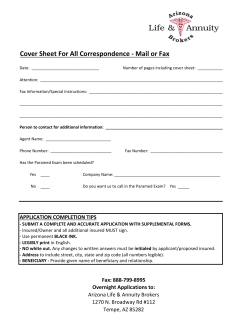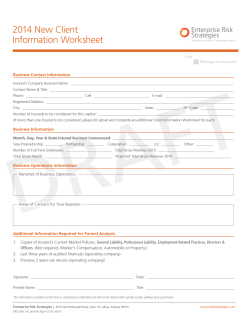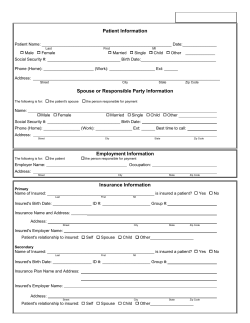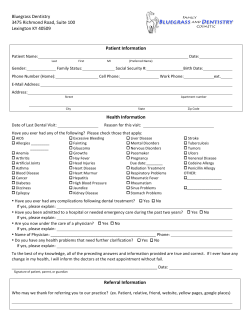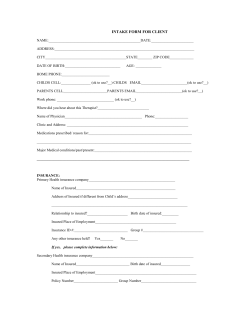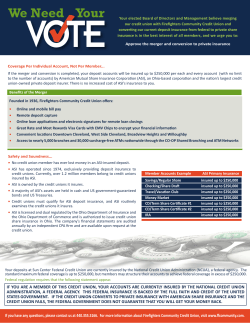
Large Group ACA Checklist 2015-2016
Health care reform checklist (For large employers) For 2015–2016 plan years Each employer that offers coverage to employees must comply with many provisions of the Affordable Care Act (ACA or health care reform law). Some provisions of the health care reform law took effect for plan years beginning on or after September 23, 2010. Other provisions will take effect through 2018. Employers with 51-100 full-time workers do not have to offer minimum value, affordable health insurance until 2016, if they meet certain conditions. The checklist below will help you determine whether or not a plan complies with the health care reform law for its 2015 and into the 2016 plan year. To find out which provisions need to be implemented for the next plan year, you need to know whether the plan is grandfathered. In general, a plan is grandfathered if it was in effect before March 23, 2010, and hasn’t had certain changes since then. Remember, grandfathered status is based on the plans and benefits in place on March 23, 2010. Under the law, grandfathered status may apply separately to each benefit plan offered under a group health plan. Once you know whether the plan has grandfathered status, use this checklist to determine whether it includes the provisions that apply to the plan. This chart is a high-level reference document only. See details about specific provisions at makinghealthcarereformwork.com. Provision Applies to Benefits and administration Out-of-pocket maximum limits applied to essential health benefits: }}$6,350 for individuals and $12,700 for families for plan years beginning on or after January 1, 2014 Grandfathered Non-grandfathered Fully insured Self-insured }}2015: — Traditional plans: $6,600 self only/$13,200 other than self only — High-Deductible Health Plans (HDHPs): $6,450 self only/$12,900 other than self only1 }}Includes deductible, coinsurance and copayments }}Rx and other services provided by vendors other than the medical plan administrator can have separate out-of-pocket maximum limits up to $6,350 for individuals and $12,700 for families in 2014: — In 2015, total out-of-pocket maximum for all services when added together cannot be more than $6,600 self only/$13,200 other than self only for traditional plans, or $6,450 self only/$12,900 other than self only for HDHPs1 — Separate out-of-pocket maximums can be set for different vendors as long as the amounts are not more than the OOPM for the year when added together No pre-existing condition exclusions regardless of age Grandfathered Non-grandfathered Fully insured Self-insured Coverage of routine care costs for patients in clinical trials (effective January 1, 2014) Grandfathered Non-grandfathered Fully insured Self-insured HIPAA nondiscrimination rules on wellness programs Grandfathered Non-grandfathered Fully insured Self-insured Wellness program maximum incentive can increase to 30%: Grandfathered Non-grandfathered Fully insured Self-insured }}Up to 50% for programs designed to prevent or reduce tobacco use 16984MUEENABS Rev. 03/15 Yes No Provision Applies to Benefits and administration (continued) Remove annual and lifetime dollar limits from essential health benefits that are covered by the plan (plan year beginning on or after January 1, 2014): Grandfathered Non-grandfathered Fully insured Self-insured }}Large group plans do not have to cover all essential health benefits, although essential health benefits that are covered cannot have a dollar limit }}Out-of-pocket cost shares for essential health benefits must apply to the out-of-pocket maximum in 2014 (refer to out-of-pocket maximum information on previous page). If plan structure has separate out-of-pocket maximum amounts for in-network and out-of-network services, cost shares for in-network essential health benefits only apply to the out-of-pocket maximum. If plan structure has combined in- and out-of-network maximum, cost shares for all essential health benefits, whether in-network or out-of-network, apply to the out-of-pocket maximum }}Fully insured plans should refer to the essential health benefits established for the state in which the policy is written }}Self-insured plans may choose any essential health benefits benchmark plan approved by the Department of Health and Human Services Coverage waiting period not to exceed 90 calendar days: }}An orientation period of one calendar month minus one day can be applied on top of the 90 days Grandfathered Non-grandfathered Fully insured Self-insured }}The 90 day waiting period must begin on the next calendar day after the orientation period ends }}Coverage must start on the 91st day, not the first of the month following 90 days Guaranteed issue (effective on January 1, 2014, at employer level) (Insurance companies cannot decline based on health status or employer contributions.) Grandfathered Non-grandfathered Fully insured Self-insured Summary of Benefits and Coverage (SBC): Grandfathered2 Non-grandfathered Fully insured Self-insured }}Update information in the document based on any plan design changes }}Add information about minimum value Notice of material modification: }}Requires plan sponsors or issuers to provide 60 days advance notice when making material modifications Grandfathered Non-grandfathered Fully insured Self-insured to the plan }}Modifications include any change to the coverage such as enhanced or reduced benefits, increased premiums or cost sharing, and new referral requirements }}Can be satisfied by sending an updated Summary of Benefits or separate written notice Taxes and fees Comparative effectiveness research fee: }}CER will explore the effectiveness, risk and benefits of medical treatments through the Patient-Centered Outcomes Research Institute }}For plan years that end October 1, 2013, through September 30, 2014, the fee is $2 per member per year (includes dependents) }}For policy and plan years beginning on or after October 1, 2014, and before October 1, 2019, the amount will be adjusted for inflation in National Health Expenditures, as determined by the Secretary of Health and Human Services }}To be paid by the plan issuer (fully insured) or plan sponsor (self-insured) based on the number of covered lives: — Self-insured (ASO) clients must pay directly to the IRS and may choose from four calculation options for the number of covered lives }}Payment must be made by July 31 of the calendar year immediately following the last day of the plan year Grandfathered Non-grandfathered Fully insured Self-insured Yes No Provision Applies to Taxes and fees (continued) Reinsurance fee: }}To be paid by the plan issuer (fully insured) or plan sponsor (self-insured) based on the number of covered lives Grandfathered Non-grandfathered Fully insured Self-insured }}Self-insured (ASO) clients pay directly to HHS and choose from four calculation options for the number of covered lives: — Report number of covered lives, due to HHS by November 15 — HHS will notify client of payment due by December 15 — Client must pay within 30 days of getting the notice from the Department of Health and Human Services Insurer fee (or health insurance tax): }}Funds premium subsidies and Medicaid expansion Grandfathered Non-grandfathered Fully insured Self-insured }}Insurer of fully insured plans pays this fee (included in premium) }}The fee is based on the insurer’s market share of net premiums written for the previous year Reporting Minimum Essential Coverage Reporting (IRS Code Section 6055): }}Reports due in 2016 for 2015 plan year and each year after: Grandfathered Non-grandfathered Fully insured Self-insured — February 28 — March 31, if filing electronically }}Provide Minimum Essential Coverage data to IRS using Form 1095–C: — Insurer will file for fully insured plans — Self-insured (ASO) groups are responsible for filing their own report; a third party may be used, but the employer is responsible for the report being complete and correct }}Give statement of Minimum Essential Coverage to workers who have information reported: — Has to include all people covered by the plan during the year — workers and dependents Employer Mandate Reporting (IRS Code Section 6056): }}Employers with 50 or more full-time workers must report Grandfathered Non-grandfathered Fully insured Self-insured }}Reports due in 2016 for 2015 plan year and each year after: — February 28 — March 31, if filing electronically }}Report Employer Mandate data to IRS using form 1094–B }}Employer is responsible for this filing }}Give Employer Mandate statement to workers who have had information reported: — Has to include all people covered by the plan during the year — workers and dependents Health Plan Identifiers (HPID):3 }}HPID is a unique identifier for health plans when such plans are identified in Health Insurance Portability and Accountability Act (HIPAA) standard transactions: — Provide consistency and a standard format for insurers and health plans to identify themselves }}Plans meeting the definition of a controlling health plan (CHP) will be required to obtain an HPID: — CHP: Health plan that controls its own business activities, or is controlled by an entity that is not a health plan }}Subhealth plans (SHPs) are not required to get an HPID (but their controlling health plan may ask or require them to do so): — SHP: Health plan whose business activities are directed by a controlling health plan }}Plans with health benefit receipts under $5 million (known as “small health plans”) need to get an HPID }}Fully insured and self-insured (ASO) groups must obtain their own HPID Grandfathered Non-grandfathered Fully insured Self-insured Yes No More tools and resources For the latest information on health care reform and our implementation efforts, please visit makinghealthcarereformwork.com. The site also includes many useful tools such as: }} A tool that can help large groups make decisions about how to comply with health care reform rules. }} An easy-to-use library. }} Podcasts, recordings and presentations about health care reform. }} An interactive timeline to help your business prepare for upcoming health care reform changes. Ask your Sales or account representative for more information about the resources above. This content is provided solely for informational purposes. It is not intended as and does not constitute legal advice. The information contained herein should not be relied upon or used as a substitute for consultation with legal, accounting, tax and/or other professional advisors. 1 With deductibles no less than $1,300 self only/$2,600 other than self only. 2 SBCs for closed plans are not yet required. The safe harbor continues to apply until further guidance is provided. 3 HHS released guidance which pushes back the requirement that plans with health benefit receipts of more than five million dollars, or “large health plans,” need to get an HPID by November 5, 2014. This also delays the enforcement of the requirement that plans with health benefit receipts under five million dollars, also known as “small health plans,” need to get an HPID by November 5, 2015. Finally, the guidance postpones health care plans having to use HPIDs in HIPAA electronic standard transactions by November 7, 2016. Each of these delays is indefinite, until further notice. Anthem Blue Cross and Blue Shield is the trade name of: In Colorado: Rocky Mountain Hospital and Medical Service, Inc. HMO products underwritten by HMO Colorado, Inc. In Connecticut: Anthem Health Plans, Inc. In Georgia: Blue Cross and Blue Shield of Georgia, Inc. In Indiana: Anthem Insurance Companies, Inc. In Kentucky: Anthem Health Plans of Kentucky, Inc. In Maine: Anthem Health Plans of Maine, Inc. In Missouri (excluding 30 counties in the Kansas City area): RightCHOICE® Managed Care, Inc. (RIT), Healthy Alliance® Life Insurance Company (HALIC), and HMO Missouri, Inc. RIT and certain affiliates administer non-HMO benefits underwritten by HALIC and HMO benefits underwritten by HMO Missouri, Inc. RIT and certain affiliates only provide administrative services for self-funded plans and do not underwrite benefits. In Nevada: Rocky Mountain Hospital and Medical Service, Inc. HMO products underwritten by HMO Colorado, Inc., dba HMO Nevada. In New Hampshire: Anthem Health Plans of New Hampshire, Inc. Anthem Health Plans of New Hampshire, Inc. HMO plans are administered by Anthem Health Plans of New Hampshire, Inc. and underwritten by Matthew Thornton Health Plan, Inc. In Ohio: Community Insurance Company. In Virginia: Anthem Health Plans of Virginia, Inc. trades as Anthem Blue Cross and Blue Shield in Virginia, and its service area is all of Virginia except for the City of Fairfax, the Town of Vienna, and the area east of State Route 123. In Wisconsin: Blue Cross Blue Shield of Wisconsin (BCBSWi), which underwrites or administers the PPO and indemnity policies; Compcare Health Services Insurance Corporation (Compcare), which underwrites or administers the HMO policies; and Compcare and BCBSWi collectively, which underwrite or administer the POS policies. Independent licensees of the Blue Cross and Blue Shield Association. ANTHEM is a registered trademark of Anthem Insurance Companies, Inc. The Blue Cross and Blue Shield names and symbols are registered marks of the Blue Cross and Blue Shield Association.
© Copyright 2025

